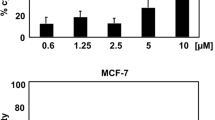Abstract
Mannosylerythritol lipid (MEL), an extracellularglycolipid from yeast, induces the differentiation ofHL-60 promyelocytic leukemia cells towardsgranulocytes. We show here that MEL is also a potentinhibitor of the proliferation of mouse melanoma B16cells. Flow-cytometric analysis of the cell cycle ofMEL-treated B16 cells revealed the accumulation ofcells in the sub-G0/G1 phase, which is a hallmark ofcells undergoing apoptosis. Treatment of B16 cellsfor 24 h with phorbol 12-myristate 13-acetate (PMA),an activator of protein kinase C (PKC), did notinterfere with the growth and survival of the cells,but it effectively counteracted the MEL-induced growtharrest and apoptosis. The activity of PKC was reducedin B16 cells treated with MEL at a concentration atwhich MEL induced apoptosis. However, incubation withPMA in addition to MEL reversed this reduction in theactivity of PKC. These results suggest thatconverging signaling pathways are triggeredindependently by MEL and PMA and that the signalsmight both be mediated by PKC.
Similar content being viewed by others
References
Appleby DW and Modak SP (1997) DNA degradation in terminally differentiating lens fiber cells from chick embryos. Proc Natl Acad Sci USA 74: 5579–5583.
Carson DA and Ribeiro JM (1993) Apoptosis and disease. Lancet 341: 1251–1254.
Darzynkiewicz Z, Bruno S, Del Bino G, Gorczyca W, Hotz MA, Lassota P and Traganos F (1992) Features of apoptotic cells measured by flow cytometry. Cytometry 13: 795–808.
Day ML, Zhao X, Wu S, Swanson PE and Humphrey PA (1994) Phorbol ester-induced apoptosis is accompanied by NGFI-A and c-fos activation in androgen-sensitive prostate cancer cells. Cell Growth Differ 5: 735–741.
De Vente JE, Kukoly CA, Bryant WO, Posekany KJ, Chen J, Fletcher DJ, Parker PJ, Pettit GJ, Lozano G, Cook PP and Ways DK (1995) Phorbol esters induce death in MCF-7 breast cancer cells with altered expression of protein kinase C isoforms: Role of p53-independent induction of gadd-45 in initiating death. J Clin Invest 96: 1874–1886.
Dive C, Gregory CD, Phipps DJ, Evans DL, Melner AE and Wyllie AH (1992) Analysis and discrimination of necrosis and apoptosis (programmed cell death) by multiparameter flow cytometry. Biochem Biophys Acta 1133: 275–285.
Emoto Y, Kisaki H, Manome Y, Kharbanda S and Kufe D (1996) Activation of protein kinase C delta in human myeloid leukemia cells treated with 1-beta-D-arabinofuranosylcytosine. Blood 87: 1990–1996.
Garzotto M, White-Jones M, Jiang Y, Ehleiter D, Liao WC, Haimovitz-Friedman A, Fuks Z and Kolesnick R (1998) 12-O-Tetradecanoylphorbol-13-acetate-induced apoptosis in LNCaP cells is mediated through ceramide synthase. Cancer Res 58: 2260–2264.
Grant S, Jarvis WD, Swerdlow P, Turner A, Traylor R, Wallace H, Lin P, Pettit G and Gewirtz DA (1992) Potentiation of the activity of 1-β-D-arabinofuranosylcytosine by the protein kinase C activator bryostatin 1 in HL-60 cells: association with enhanced fragmentation of mature DNA. Cancer Res 52: 6270–6278.
Gruber J R, Ohno S and Niles RM (1992) Increased expression of protein kinase Cα plays a key role in retinoic acid-induced melanoma differentiation. J Biol Chem 267: 13356–13360.
Haimovitz-Friedman FA, Balaban N, McLoughlin M, Ehleiter D, Micheali J, Vlodavsky I and Fuks Z (1994) Protein kinase C mediates basic fibroblast growth factor protection of endothelial cells against radiation-induced apoptosis. Cancer Res 54: 2591–2597.
Hakomori S (1981) Glycosphingolipids in cellular interaction, differentiation, and oncogenesis. Annu Rev Biochem 50: 733–764.
Hakomori S and Igarashi Y (1992) Gangliosides and glycosphingolipids as modulators of cell growth, adhesion and transmembrane signaling. Adv Lipid Res 25: 147–162.
Hannun YA and Bell RM (1989) Functions of sphingolipids and sphingolipid breakdown products in cellular regulation. Science 243: 500–507.
Isoda H, Shinmoto H, Kitamoto D, Matsumura M and Nakahara T (1997) Differentiation of human promyelocytic leukemia cell line HL-60 by microbial extracellular glycolipids. Lipids 32: 263–271.
Jarvis WD, Kolesnick PN, Fornari FA, Traylor RS, Gewirtz DA and Grant S (1994) Induction of apoptotic DNA damage and cell death by activation of the sphingomyelin pathway. Proc Natl Acad Sci USA 91: 73–77.
Kitamoto D, Akiba S, Hioki T and Tabuchi T (1990) Extracellular accumulation of mannosylerythritol lipid by a strain of Candida antarctica. Agric Biol Chem 54: 31–36.
Kizaki H, Tadakura T, Odaka C, Muramatsu J and Ishimura Y (1989) Activation of a suicide process of thymocytes through DNA fragmentation by calcium ionophores and phorbol esters. J Immunol 143: 1790–1794.
Koh HK (1991) Cutaneous melanoma. N Engl J Med 325: 171–182.
Nishizuka Y (1992) Intracellular signaling by hydrolysis of phospholipids and activation of protein kinase C. Science 258: 607–614.
Livneh E and Fishman DD (1997) Linking protein kinase C to cellcycle control. Eur J Biochem 248: 1–9.
Lotem J, Cragoe EJ and Sachs L (1991) Rescue from programmed cell death in leukemic and normal myeloid cells. Blood 78: 953–960.
Newton AC (1995) Protein kinase C: structure, function, and regulation. J Biol Chem 270: 28495–28498.
Obeid LM, Linardic CM, Karolak LK and Hannun YA (1993) Programmed cell death induced by ceramide. Science 259: 1769–1771.
Topham MK, Bunting M, Zimmerman GA, McIntyre TM, Blackshear PJ and Prescott SM (1998) Protein kinase C regulates the nuclear localization of diacylglycerol kinase-zeta. Nature 394: 697–700.
Young CY, Murtha PE and Zhang J (1994) Tumor-promoting phor130 bol ester-induced cell death and gene expression in a human prostate adenocarcinoma cell line. Oncol Res 6: 203–210.
Zhao XX, Wakamatsu Y, Shibahara M, Nomura N, Geltinger C, Nakahara T, Murata T and Yokoyama KK (1999) Mannosylerythritol lipid is a potent inducer of apoptosis and differentiation of mouse melanoma cells in culture. Cancer Res 59: 482–486.
Author information
Authors and Affiliations
Corresponding author
Rights and permissions
About this article
Cite this article
Zhao, X., Geltinger, C., Kishikawa, S. et al. Treatment of mouse melanoma cells with phorbol 12-myristate 13-acetate counteracts mannosylerythritol lipid-induced growth arrest and apoptosis. Cytotechnology 33, 123–130 (2000). https://doi.org/10.1023/A:1008129616127
Issue Date:
DOI: https://doi.org/10.1023/A:1008129616127




